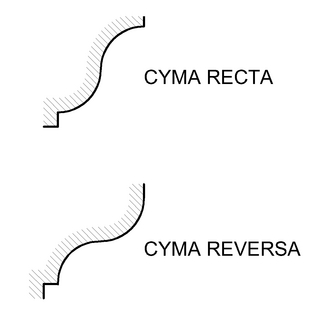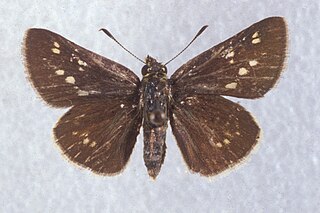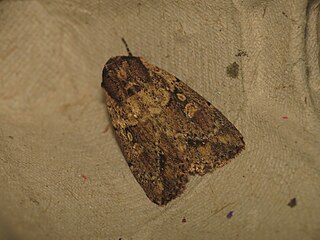
An ogee ( ) is the name given to objects, elements, and curves—often seen in architecture and building trades—that have been variously described as serpentine-, extended S-, or sigmoid-shaped. Ogees consist of a "double curve", the combination of two semicircular curves or arcs that, as a result of a point of inflection from concave to convex or vice versa, have ends of the overall curve that point in opposite directions.

An entablature is the superstructure of moldings and bands which lies horizontally above columns, resting on their capitals. Entablatures are major elements of classical architecture, and are commonly divided into the architrave, the frieze, and the cornice. The Greek and Roman temples are believed to be based on wooden structures, the design transition from wooden to stone structures being called petrification.

Histioteuthis is a genus of squid in the family Histioteuthidae. It goes by the common name cock-eyed squid, because in all species the right eye is normal-sized, round, blue and sunken; whereas the left eye is at least twice the diameter of the right eye, tubular, yellow-green, faces upward, and bulges out of the head.

The ovolo or echinus is a convex decorative molding profile used in architectural ornamentation. Its profile is a quarter to a half of a more or less flattened circle.

Cymatium, the uppermost molding at the top of the cornice in the classical order, is made of the s-shaped cyma molding, combining a concave cavetto with a convex ovolo. It is characteristic of Ionic columns and can appear as part of the entablature, the epistyle or architrave, which is the lintel or beam that rests on the capitals of columns, and the capital itself. Often the cymatium is decorated with a palmette or egg-and-dart ornament on the surface of the molding.
The heights of the parts of the capital are to be so regulated that three of the nine parts and a half, into which it was divided, lie below the level of the astragal on the top of the shaft. The remaining parts are for the cymatium, abacus, and channel. The projection of the cymatium beyond the abacus is not to be greater than the size of the diameter of the eye [of the volute].
Eschweilera reversa, synonym Eschweilera pittieri, is a species of woody plant in the Lecythidaceae family. It is found in Colombia, Ecuador, and Panama.

Histioteuthis reversa, commonly known as the reverse jewel squid or the elongate jewel squid, is a species of cock-eyed squid, so called because the eyes are dissimilar. It occurs at moderate depths in the Atlantic Ocean and Mediterranean Sea and is also known from the Indian Ocean.
Parapammene is a genus of moths belonging to the subfamily Olethreutinae of the family Tortricidae.

Amblyscirtes reversa, the reversed roadside skipper, is a butterfly of the family Hesperiidae. The species was first described by Frank Morton Jones in 1926. It has a scattered distribution from south-eastern Virginia, south to northern Georgia. It is also found in southern Mississippi and southern Illinois.
Prosipho reversa is a species of sea snail, a marine gastropod mollusk in the family Buccinidae, the true whelks.

Haploa reversa, the reversed haploa, is a moth of the family Erebidae. The species was first described by Stretch in 1885. It is found in North America, from south-eastern Illinois, Iowa, Kansas, New York, Oklahoma and Wisconsin.
Icimauna is a genus of longhorn beetles of the subfamily Lamiinae, containing the following species:
Encrasima reversa is a moth in the family Autostichidae. It was described by Edward Meyrick in 1916. It is found in Sri Lanka.
Icimauna angaba is a species of beetle in the family Cerambycidae. It was described by Martins and Galileo in 1991. It is known from Costa Rica.
Icimauna aysa is a species of beetle in the family Cerambycidae. It was described by Martins and Galileo in 1991. It is known from Panama and Costa Rica.
Icimauna sarauaia is a species of beetle in the family Cerambycidae. It was described by Martins and Galileo in 1991. It is known from Brazil and Bolivia.
Icimauna pallidipennis is a species of beetle in the family Cerambycidae. It was described by Martins and Galileo in 2007. It is known from Costa Rica.
Icimauna ciliaris is a species of beetle in the family Cerambycidae. It was described by Johann Christoph Friedrich Klug in 1825. It is known from Argentina, Brazil and Paraguay.
Icimauna macilenta is a species of beetle in the family Cerambycidae. It was described by Henry Walter Bates in 1881. It is known from Brazil.

Mythimna reversa is a moth of the family Noctuidae first described by Frederic Moore in 1884. It is found in the Indian subregion, Sri Lanka, Borneo, the Philippines, Hong Kong, Malaysia and Australia.







